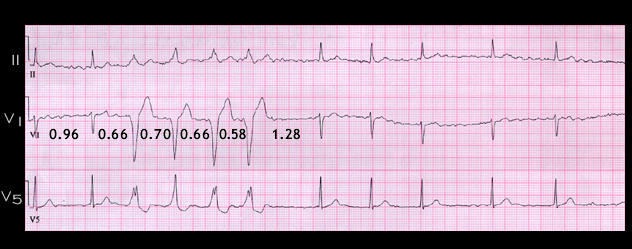
The first of wide complex beat suggests left bundle branch block and satisfies the criteria for aberrant conduction. Its coupling interval is short (0.66 seconds) and it is preceded by a long RR interval (0.96 seconds). The second of the four wide complex beats follows the first with an RR interval of 0.70 seconds. Its QRS complex is less wide than its predecessor, suggesting that the left bundle may have begun to recover its excitability and is only partially refractory. The next two wide complex beats have shorter RR intervals (0.66 and 0.58 seconds) and their QRS complexes are wider. The bundle branch block dissipates when the RR interval lengthens to 1.28 seconds. This analysis indicates that the wide complex beats are all aberrantly conducted. They are an example of rate dependent left bundle branch block.
